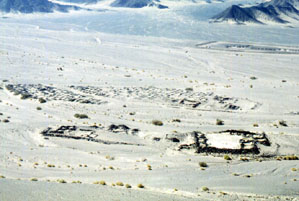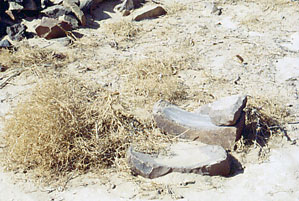|
Overview of the settlement of al-Guzzah with the
gold working area in the foreground, the settlement in the middle of the
picture and the large well in the background:
|
|
Apart from a long channel to separate the gold from
the quartz it is captured in, either with water or mercury, many grinding
stones typical for ancient gold mines were seen in al-Guzzah:
|
|
|
|
|

|
|

|
|
|
|
|
|
|
|
|
Objective of visit:
|
|
To draw a measured plan of the site and study the surface
remains (including the ceramic finds). |
|
Date of visit:
|
|
- July 1996 |
|
Fellow visitors:
|
|
Prof.Dr. Steve Sidebotham (University of Delaware) and
Saleh Ali (our bedouin guide). |
| Results: |
|
A survey was performed using the Global Positioning System,
a theodolite and steel tape measures. Off-site assistance was given by
pottery expert Dr. Roberta Tomber (Museum of London). No excavations took
place. A full publication of this site is pending. |
| Approximate position and date
of the site: |
|
al-Guzzah is in the central part of the Egyptian Eastern
desert, just north of the Qena-Safaga asphalt road. Surface pottery dated
to the Ptolemaic period (ca. 330 - 30 BC). |
| Short description of the site: |
|
al-Guzzah was a gold mine which was operational in Ptolemaic
times. There are many remains of ancient structures, including a fort,
many huts and a large well in the middle of the wadi. |
| Additional remarks: |
|
A large graveyard was found just west of the settlement.
Our work was sponsored by the University of Delaware and private donors. |
| HOME |
|
|
 |
|
|